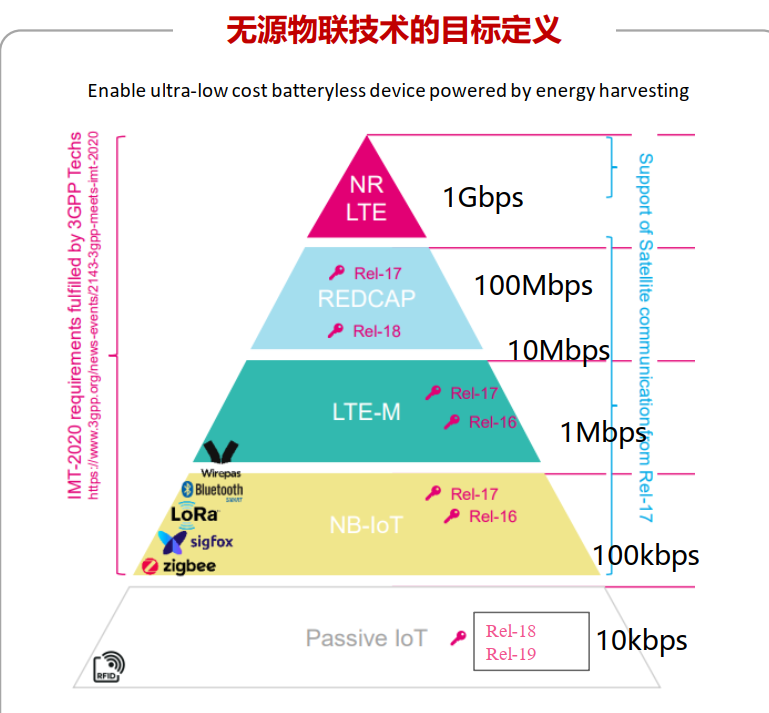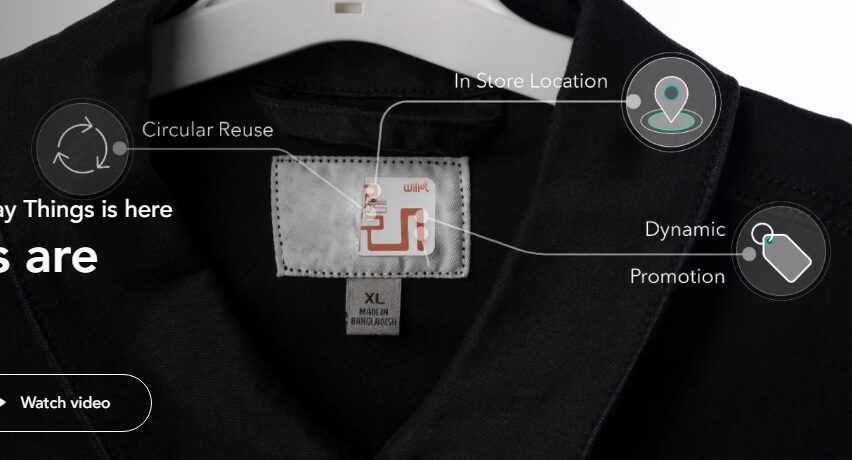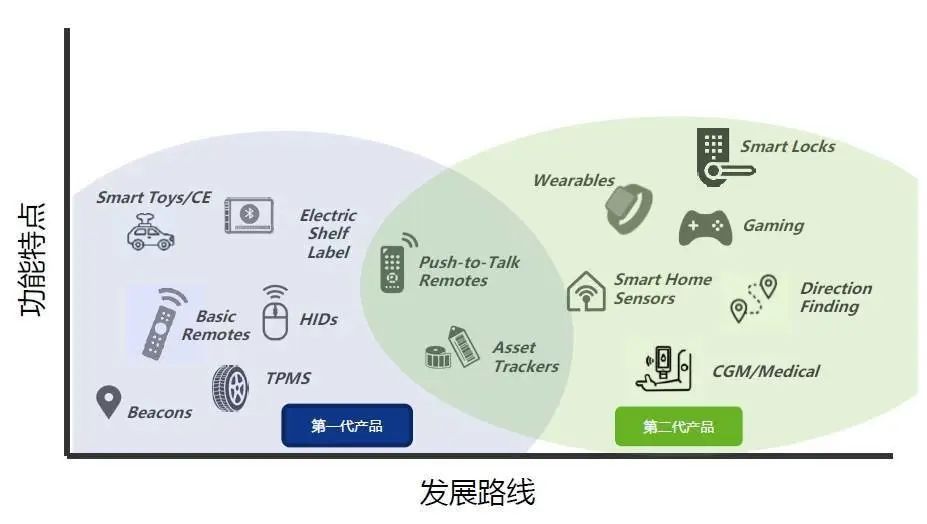Skip to content
Achieving the “Internet of Everything” is the ultimate goal of the entire IoT industry. According to IoT Analytic statistics, the number of active IoT terminals worldwide is expected to grow to 27 billion by 2025, but there is still a significant gap from the industry-expectation of a trillion-level market. With the deep expansion of IoT scenarios, the rigid constraints of terminal costs and the energy supply limitations brought by application scenarios have become prominent. From the trend of IoT connection development, the future trillion-level “Internet of Everything” will undoubtedly be built on the foundation of passive IoT.
Passive IoT refers to terminal node devices that connect to the network without needing power lines or built-in batteries. They support normal operation by collecting micro-energy from the environment, enabling functions such as data collection, transmission, and distributed computing.
The technical goal definition of passive IoT comes from: IoT Media
Some viewpoints believe that passive IoT is a derivative concept of RFID technology, equating passive IoT with RFID technology, and even confusing passive IoT devices with “tags”, which is a result of cognitive bias. While RFID technology indeed matches passive IoT on the key point of “passive”, current RFID functions are single and cannot meet the multifaceted needs of IoT that integrates communication, perception, and edge computing, limiting them to “tag” applications and unable to expand to other scenarios. In fact, as early as 2021, Huawei proposed the concept of the 5.5G passive IoT solution: expanding the transmission distance of scenarios supported by passive IoT devices to hundreds of meters, discarding dedicated readers and switching to universal devices, allowing terminals to have the ability to self-backhaul data through cellular gateway nodes.
Huawei’s conceptual solution points towards ultra-low power BLE technology. In response, the domestic IoT Bluetooth chip manufacturer Fengjia Technology has provided a complete self-developed, domestically produced passive IoT chip solution.
1. Ultra-Low Power IoT System-Level Chip Architecture
Fengjia Technology has years of successful practice in the IoT field. In response to the high performance, high reliability, high security, and high energy efficiency demands of passive IoT, it has developed a chip architecture and on-chip power/clock management method that integrates hardware and software, achieving a highly integrated, ultra-low power system-level chip stack. Based on a high energy efficiency hierarchical management model, it realizes low-power management of core needs such as energy collection and storage from the passive IoT environment, event recognition and drive, and edge computing. The functionality covers all the needs of passive IoT, expanding applications to voice large model data entry terminals, self-organizing sensor networks, wearable medical continuous electrochemical monitoring, smart control of new energy vehicles, asset location tracking, and other segmented scenarios.
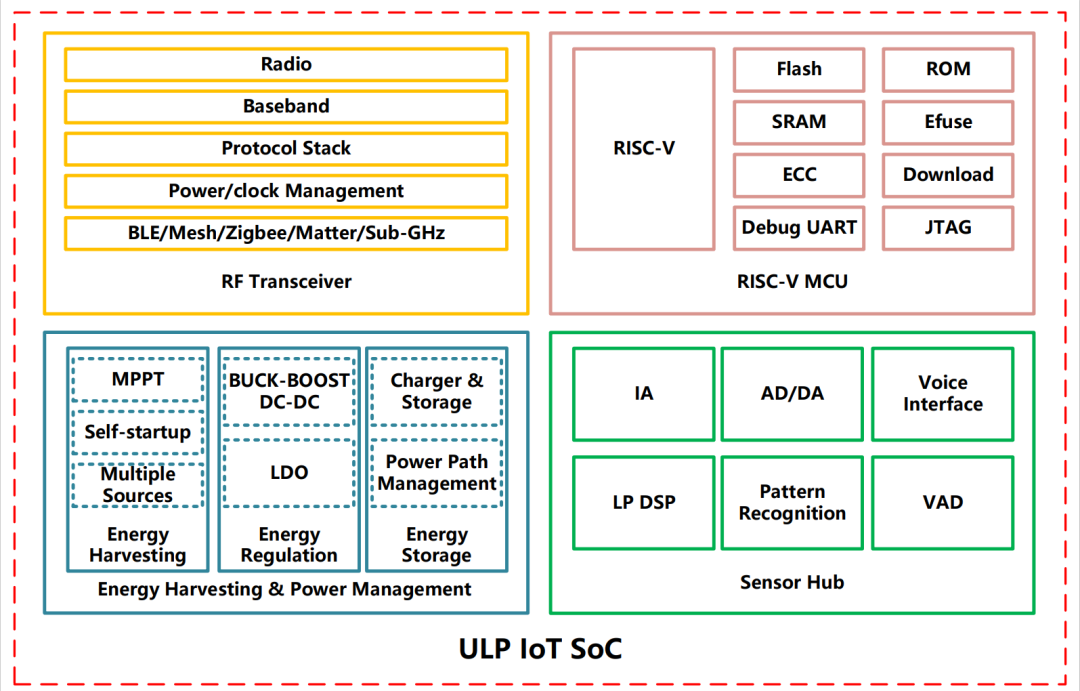 2. Ultra-Low Power Multi-Mode Wireless Communication Hardware-Software Collaborative Design
The chip integrates an ultra-low power multi-mode RF transceiver, on-chip communication collaborative power/clock management, baseband processor, and software protocol stack, breaking through the limitations of power consumption on noise figure, linearity, dynamic range, and integration, enabling RF performance to reach sub-milliwatt levels; supporting diverse communication protocols such as BLE/Mesh/Zigbee/Matter/Sub-GHz, achieving full coverage of local/wide area IoT.
To break through the inherent trend of maintaining wireless connections with self-organizing network timing wake-up for high energy efficiency wireless self-organizing network protocols, a hierarchical RF wake-up method within the self-organizing network has been self-developed, while also designing a self-organizing network protocol that balances multiple parameters such as dynamic power consumption, wireless communication distance, and rate based on routing information to adaptively adjust communication rates between sensor nodes.
3. Self-Instructed RISC-V Processor Secure Processor
Based on the high security requirements of IoT data, the chip integrates a Montgomery hardware key generator based on the MCU encryption secure boot mechanism and multi-level pipeline architecture, providing a secure code execution space scheme based on the RISC-V self-instructed set and memory mapping.
The chip integrates Flash, ROM, SRAM, Efuse, etc., while designing a low-power storage system to ensure the performance and reliability of fast and continuous access to data in IoT scenarios.
4. Multi-Source Collaborative High-Efficiency Energy Collection and Management
In response to the indispensable energy collection needs of passive IoT, to solve the issues of multi-source collaborative energy acquisition, low-voltage cold start of circuits, and high-efficiency energy conversion, management, and storage, Fengjia employs a dual-mode energy collection and voltage conversion architecture based on buck-boost and maximum power point tracking with hierarchical self-starting technology, designing a reconfigurable energy collection circuit based on micro-light energy, micro-motion energy, temperature difference energy, RF energy, etc., achieving interface circuit matching, adaptive adjustment of MPPT circuit state optimization parameters, and improving multi-source collaborative energy acquisition efficiency.
5. Ultra-Low Power Multi-Physical Quantity Sensors
To meet the sensory function requirements of IoT devices, Fengjia has designed a near-threshold low-power high-precision signal chain circuit, reducing the amount of ineffective interference data through low-power hierarchical mode recognition technology, achieving single-chip integration of multi-mode low-power sensor interfaces for environmental signals such as sound, vibration, light, electrochemical, and electromagnetic fields.
Self-developed lightweight convolutional neural networks based on embedded processors are used for extracting and recognizing key sensing information, achieving independently operable ultra-low power multi-physical quantity sensor interfaces and intelligent sensing information processing systems.
Passive IoT based on BLE has already seen successful cases internationally. The BLE product Wiliot IoT Pixels from the Israeli company Wiliot powers itself by capturing weak signals from 4G/5G, Wi-Fi, Zigbee, LoRa, etc. This micro-sized, low-cost self-powered tag, which is only the size of a postage stamp, can sense a series of physical and environmental data including temperature, liquid level, motion, position change, humidity, and proximity, and then input this data into the Wiliot cloud. This product is currently used in consumer production and retail scenarios such as vaccine vials and food packaging.
Wiliot IoT Pixels, Source: Wiliot
Atmosic, a company from the United States, further expands the usage scenarios of BLE passive IoT devices. Atmosic believes that by 2024, the IoT device market will increasingly favor devices with stronger processing capabilities, more features (security and positioning), and lower power consumption (passive). Taking the rapidly growing market demand for wearable portable medical products as an example, which requires very thin dimensions but also reliable battery performance, providing uninterrupted monitoring functionality for extended periods.
Atmosic chip terminal device positioning, Source: Atmosic
Fengjia Technology (Shanghai) Co., Ltd. focuses on high-performance RF and mixed-signal chip design, independently developing a complete set of high-performance mixed-signal IP systems with independent intellectual property rights based on 28nm/55nm/180nm processes, possessing core technologies such as multi-standard communication protocol stacks, high-performance low-power RF circuits, high-performance ADC/DAC, ultra-high-speed SerDes and clocks, flexible and secure system-level chip architecture, and digital signal processing algorithms, with a complete design, mass production, and quality system. The low-power Bluetooth chip PHY62XX series has core RF performance and power consumption indicators that are internationally leading, certified by the Bluetooth Special Interest Group, CSA, and Apple MFi, with customers covering industrial, medical, voice, automotive, and consumer sectors, with over 500 million chips delivered cumulatively.
2. Ultra-Low Power Multi-Mode Wireless Communication Hardware-Software Collaborative Design
The chip integrates an ultra-low power multi-mode RF transceiver, on-chip communication collaborative power/clock management, baseband processor, and software protocol stack, breaking through the limitations of power consumption on noise figure, linearity, dynamic range, and integration, enabling RF performance to reach sub-milliwatt levels; supporting diverse communication protocols such as BLE/Mesh/Zigbee/Matter/Sub-GHz, achieving full coverage of local/wide area IoT.
To break through the inherent trend of maintaining wireless connections with self-organizing network timing wake-up for high energy efficiency wireless self-organizing network protocols, a hierarchical RF wake-up method within the self-organizing network has been self-developed, while also designing a self-organizing network protocol that balances multiple parameters such as dynamic power consumption, wireless communication distance, and rate based on routing information to adaptively adjust communication rates between sensor nodes.
3. Self-Instructed RISC-V Processor Secure Processor
Based on the high security requirements of IoT data, the chip integrates a Montgomery hardware key generator based on the MCU encryption secure boot mechanism and multi-level pipeline architecture, providing a secure code execution space scheme based on the RISC-V self-instructed set and memory mapping.
The chip integrates Flash, ROM, SRAM, Efuse, etc., while designing a low-power storage system to ensure the performance and reliability of fast and continuous access to data in IoT scenarios.
4. Multi-Source Collaborative High-Efficiency Energy Collection and Management
In response to the indispensable energy collection needs of passive IoT, to solve the issues of multi-source collaborative energy acquisition, low-voltage cold start of circuits, and high-efficiency energy conversion, management, and storage, Fengjia employs a dual-mode energy collection and voltage conversion architecture based on buck-boost and maximum power point tracking with hierarchical self-starting technology, designing a reconfigurable energy collection circuit based on micro-light energy, micro-motion energy, temperature difference energy, RF energy, etc., achieving interface circuit matching, adaptive adjustment of MPPT circuit state optimization parameters, and improving multi-source collaborative energy acquisition efficiency.
5. Ultra-Low Power Multi-Physical Quantity Sensors
To meet the sensory function requirements of IoT devices, Fengjia has designed a near-threshold low-power high-precision signal chain circuit, reducing the amount of ineffective interference data through low-power hierarchical mode recognition technology, achieving single-chip integration of multi-mode low-power sensor interfaces for environmental signals such as sound, vibration, light, electrochemical, and electromagnetic fields.
Self-developed lightweight convolutional neural networks based on embedded processors are used for extracting and recognizing key sensing information, achieving independently operable ultra-low power multi-physical quantity sensor interfaces and intelligent sensing information processing systems.
Passive IoT based on BLE has already seen successful cases internationally. The BLE product Wiliot IoT Pixels from the Israeli company Wiliot powers itself by capturing weak signals from 4G/5G, Wi-Fi, Zigbee, LoRa, etc. This micro-sized, low-cost self-powered tag, which is only the size of a postage stamp, can sense a series of physical and environmental data including temperature, liquid level, motion, position change, humidity, and proximity, and then input this data into the Wiliot cloud. This product is currently used in consumer production and retail scenarios such as vaccine vials and food packaging.
Wiliot IoT Pixels, Source: Wiliot
Atmosic, a company from the United States, further expands the usage scenarios of BLE passive IoT devices. Atmosic believes that by 2024, the IoT device market will increasingly favor devices with stronger processing capabilities, more features (security and positioning), and lower power consumption (passive). Taking the rapidly growing market demand for wearable portable medical products as an example, which requires very thin dimensions but also reliable battery performance, providing uninterrupted monitoring functionality for extended periods.
Atmosic chip terminal device positioning, Source: Atmosic
Fengjia Technology (Shanghai) Co., Ltd. focuses on high-performance RF and mixed-signal chip design, independently developing a complete set of high-performance mixed-signal IP systems with independent intellectual property rights based on 28nm/55nm/180nm processes, possessing core technologies such as multi-standard communication protocol stacks, high-performance low-power RF circuits, high-performance ADC/DAC, ultra-high-speed SerDes and clocks, flexible and secure system-level chip architecture, and digital signal processing algorithms, with a complete design, mass production, and quality system. The low-power Bluetooth chip PHY62XX series has core RF performance and power consumption indicators that are internationally leading, certified by the Bluetooth Special Interest Group, CSA, and Apple MFi, with customers covering industrial, medical, voice, automotive, and consumer sectors, with over 500 million chips delivered cumulatively.
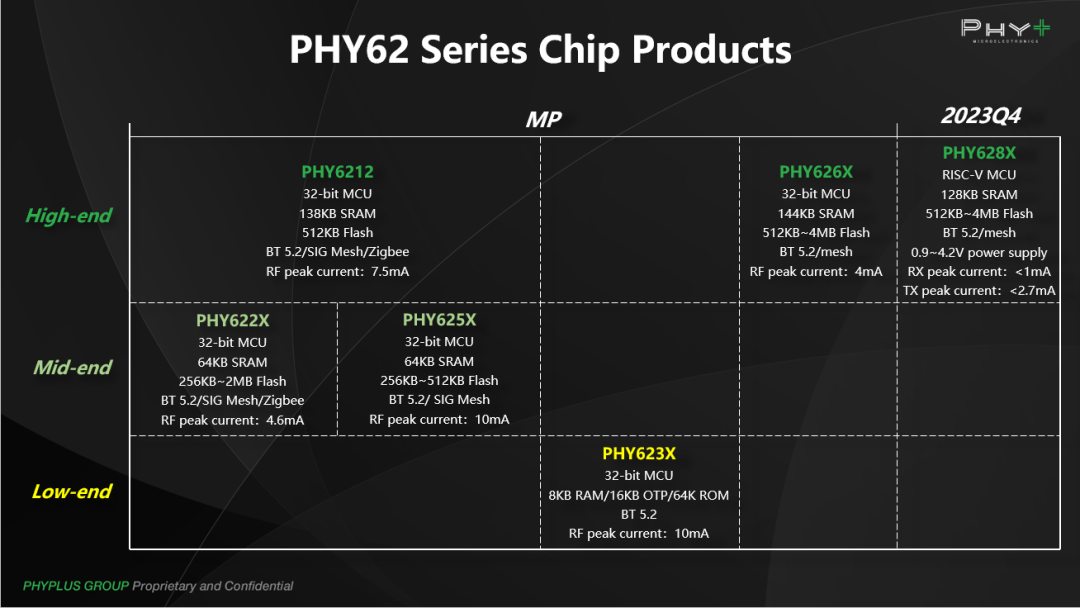 Fengjia is actively laying out ultra-low power, multi-modal, fully stack self-owned intellectual property wireless IoT system-level chips based on new integrated high-performance RISC-V, environmental energy collection circuits, ultra-low power IoT RF transceiver circuit architecture, and RF wake-up technology, as well as diversified communication protocol stacks such as BLE/Mesh/Zigbee/Matter/Sub-GHz, to meet the low-power, diversity, security, and high reliability needs of IoT. It is expected to release the first generation of series products by the end of 2023 and achieve deployment of tens of millions of applications in multiple fields within two years.
Fengjia is actively laying out ultra-low power, multi-modal, fully stack self-owned intellectual property wireless IoT system-level chips based on new integrated high-performance RISC-V, environmental energy collection circuits, ultra-low power IoT RF transceiver circuit architecture, and RF wake-up technology, as well as diversified communication protocol stacks such as BLE/Mesh/Zigbee/Matter/Sub-GHz, to meet the low-power, diversity, security, and high reliability needs of IoT. It is expected to release the first generation of series products by the end of 2023 and achieve deployment of tens of millions of applications in multiple fields within two years.
